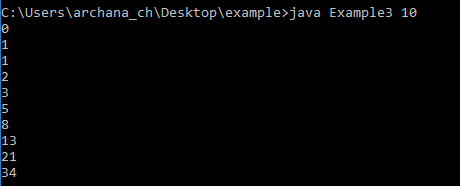Full Stack Development Internship Program
- 29k Enrolled Learners
- Weekend/Weekday
- Live Class
Java programming language is versatile in every aspect, being platform-independent it makes Java a clear cut winner for any developer. The execution of any Java program is hustle-free and precise. We can even pass arguments during execution of a program using the command-line arguments. In this article, you will learn how you could use command-line arguments in Java. Following are the topics discussed in this blog:
The command-line arguments are passed to the program at run-time. Passing command-line arguments in a Java program is quite easy. They are stored as strings in the String array passed to the args parameter of main() method in Java.
class Example0{
public static void main(String[] args){
System.out.println("edureka" + args[0]);
}
}
Output:
To compile and run a java program in command prompt follow the steps written below.
Save your program in a file with a .java extension
open the command prompt and go to the directory where your file is saved.
Run the command – javac filename.java
After the compilation run the command – java filename
Make sure the Java path is set correctly.
Here are a few examples to show how we can use the command-line arguments in a Java program.
The beauty relies on the parseInt method in the Integer class. Every Number classes such as Integer, Float, Double and so on have parseXXX methods that convert String into the respective object of their type.
As we all know that array starts its index with zero. Therefore args[0] is the first index in this String[] array which is taken from the console. Similarly, args[1] is second, args[2] is the third element and so on.
When an application is launched, the run-time system passes the command-line arguments to the application’s main method via an array of Strings.
class Example1{
public static void main(String[] args){
int a , b = 1;
int n = Integer.parseInt(args[0]);
for(a = 1; a<= n ; a++)
{
b = b*a;
}
System.out.println("factorial is" +b);
}
}
Output: ![]()
class Example2{
public static void main(String[] args){
int a = Integer.parseInt(args[0]);
int b = Integer.parseInt(args[1]);
int sum = a + b;
System.out.println("The sum is" +sum);
}
}
Output: ![]()
class Example3{
public static void main(String[] args){
int n = Integer.parseInt(args[0]);
int t1 = 0;
int t2 = 1;
for(int i = 1; i <=n; i++){
System.out.println(t1);
int sum = t1+t2;
t1 = t2;
t2 = sum;
}
}
}
Output: 
While launching your application, you can use the command-line arguments to specify the configuration information.
When you are using command-line arguments, there is no limitation on the number of arguments. You can use as many as per your requirement.
Information in the command-line arguments is passed as Strings.
The command-line arguments are stored in the String args of the main() method of the program.
Related Learning: Java Interview Questions for 3 Years Experience
This brings us to the end of this article where we have learned about the Java command line arguments with examples. I hope you are clear with all that has been shared with you in this tutorial. If you’re just beginning, then watch at this Java Tutorial to Understand the Fundamental Java Concepts.
If you found this article on “Java Command Line Arguments” relevant, check out Edureka’s Java Certification Training. It is a trusted online learning company with a network of more than 250,000 satisfied learners worldwide.
We are here to help you with every step on your journey and have developed a curriculum designed for students and professionals who want to become Java Developers. The course is designed to give you a head start into Java programming and train you for both core and advanced Java concepts, along with various Java frameworks like Hibernate and Spring.
If you have any questions, feel free to ask them in the comments section of “Java Command Line Arguments,” and our team will be glad to answer.
 Thank you for registering Join Edureka Meetup community for 100+ Free Webinars each month JOIN MEETUP GROUP
Thank you for registering Join Edureka Meetup community for 100+ Free Webinars each month JOIN MEETUP GROUPedureka.co